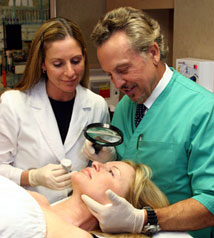Approximately 1,000,000 new cases of skin cancer are diagnosed in the United States each year. This represents the most common type of cancer affecting any single organ of the body, and constitutes roughly 20% of all cancers in men and over 10% of all cancers in women. Approximately 20,000 deaths are attributed to complications from skin cancers each year. If cancerous lesions are discovered and treated early, the cure rate is as high as 98% or better.

Most skin cancers appear after the fourth decade of life, and very few people take preventive measures until the first cancer occurs. Many of us are not concerned about sun exposure during childhood and adolescence, even though this constitutes a substantial amount of the total cancer-causing sun exposure received in a lifetime. The feeling of well-being and enjoyment that we have while in the sun must be tempered with certain precautions. Other causes of skin cancers include exposure to x-ray radiation for the treatment of a variety of dermatologic conditions including acne vulgaris. Also, the ingestion of arsenical compounds has been associated with the development of skin cancers. In some cases skin cancers can develop and may be induced by human papillomavirus (HPV).
Skin cancers do not cause pain or other symptoms unless the tumor has either invaded underlying tissue or led to an ulceration. When skin cancer reappears near an area of prior treatment, it may indicate either a recurrence or the development of a new cancer. A person with one cancer is more likely to develop others. There is approximately a 35% chance of developing a future skin cancer in patients who have had one cancer within the last year and a half. Those who develop skin cancer at an earlier age are more likely to develop additional skin cancers at a later age.
Skin Cancer and Sun Exposure
- The relationship between sun exposure and the development of skin cancer has been conclusively established. The culprit is cumulative damage over many years of being in the sun, rather than the result of a single episode of sun damage. Skin cancers are found predominantly in light-skinned individuals of Scandinavian descent. However, they do develop in darker-skinned individuals as well, but usually require more intense sunlight in greater amounts in order to do so. These cancers are found predominantly on exposed areas of the skin which are more likely to have endured excessive ultraviolet rays from the sun. However, cancers can also develop on the scalp and lower extremities.
- Actinic keratoses are small, reddish-brown scaly patches that occur on exposed surfaces, especially on the face and backs of the hands and arms in persons regularly exposed to the sun over many years. These are pre-malignant lesions, some of which will gradually thicken and become skin cancers.
- Repeated and prolonged sun exposure also causes increased wrinkling of the skin and a weathered, leathery skin texture with patchy discoloration.
- The most common result of overexposure to the sun is sunburn which can be prevented with proper sunscreen. With sun exposure, pigmented cells are stimulated to produce melanin, causing increased skin coloring (sun tan). Light-skinned individuals have less protection against sun exposure. A tan is your body’s mechanism of trying to repair the damage caused by the sun.
- Intense and frequent sunburns can increase the risk of malignant transformation of moles (nevi). The earliest sign is an alteration in the size, shape, or color of the mole. It may appear irritated with scaling or bleeding, and subsequently thicken.
Types of Skin Cancer
Basal Cell Carcinoma
The most common type of skin cancer is basal cell carcinoma, which has virtually no tendency to metastasize. The complications, however, include gradual enlargement, penetration into cartilage, bone, muscle, and nerve tissue, ulceration, as well as bleeding.
Squamous Cell Carcinoma
Squamous cell carcinoma is the second most common skin cancer. This type of skin cancer has the potential to spread to other parts of the body, usually after many months without treatment. Squamous cell carcinoma can appear in an old burn scar, areas of repeated irritation, and non-healing wounds.
Melanoma
The third type of skin cancer is Melanoma. This is an aggressive form of skin cancer that can spread to other parts of the body if left untreated. Click here to learn more about moles and the ABCDEs of Melanoma.
Treatments for Skin Cancers
First, a biopsy is performed to establish the diagnosis. Selecting a specific treatment for a particular skin cancer depends on the type of tumor, location, size, depth of tissue invasion, and other medical factors. All methods of cancer treatment require destruction of the cancer cells. A particular method of treatment is selected which will give the best results in terms of removal of the tumor as well as cosmetic appearance… Treatment may include one of the following:
- Superficial Radio-Therapy (SRT)
- Cryosurgery
- Curettage and Electrodessication
- Photodynamic therapy
- Topical chemotherapeutic or immunomodulating drugs
- Surgical excision
- Mohs micrographic surgery
- Hedgehog pathway inhibitors (Vismodegib) – for those with multiple large basal cell carcinomas
- Topicals – 5-Fluorouracil (5-Fu) or Aldara (imiquiod)
- Injectables – Intralesional 5-Fluorouracil (5-Fu)
Once your skin cancer has been treated it is imperative that you maintain proper follow-up and surveillance since having one skin cancer increases your risk of obtaining future skin cancers. Sun protection and regular skin exams will help us diagnose skin cancers for people in long beach at their earliest stages when they can be optimally treated.
Contact us today to schedule an appointment with one of our experts.
*There is no guarantee of specific results. Individual results may vary*





